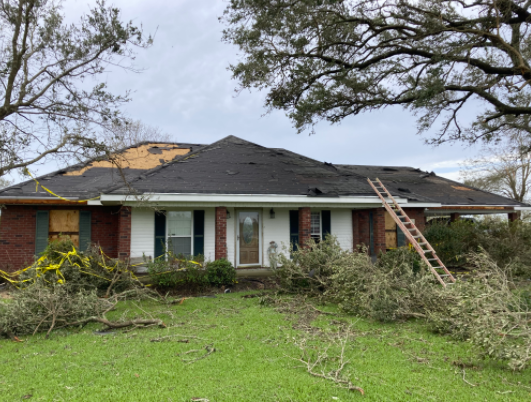
CANCELED: Level II Endangered/Missing Child Advisory issued for 14-year-old female
May 31, 2021
Houma man arrested for attempted murder following shooting on Alma Street
June 1, 2021By Tobie Blanchard, LSU Ag
The record-breaking 2020 hurricane season, in the midst of the COVID-19 pandemic, saw 30 named storms, with 12 making landfall in the continental United States. The National Oceanic and Atmospheric Administration is predicting another active season with between 13 and 20 named storms, six to 10 hurricanes and three to five major hurricanes (category 3 or above).
Between hurricanes, freezes and floods, Louisiana has been hit hard by numerous natural disasters in the past year. And while there is no way to be 100% prepared, the LSU AgCenter recommends measures to mitigate potential damage and losses. These include preparations for yards, homes, pets and having food and cleaning supplies.
Although many COVID-19 restrictions have been lifted, certain precautions should still be taken. AgCenter food safety expert Wennie Xu said cleaning and disinfecting items such as soap, hand sanitizer, disinfecting wipes, or general household cleaning and disinfecting supplies for surfaces are important, especially if a storm necessitates cleanup because of floodwaters or storm damage.
Having a three-day water supply is important. “It is best to buy bottled water and prepare for one gallon of water per day per person,” she said.
To keep food safe in the event of a power outage, keep the doors of your refrigerator and freezer shut as much as possible. “Frozen foods can be safely refrozen if they still have ice crystals on them or the temperature is 40 degrees or lower,” Xu said.
She also said to make sure you have a manual can opener, a food thermometer to monitor temperature and bleach if you need to sanitize utensils, pots and water.
Finally, if you or your family is forced to evacuate to a shelter, Xu said it’s important to follow that individual shelter’s safety policies.
AgCenter instructor and registered dietitian Sandra May said when preparing for a hurricane, keep in mind foods that do not have to be refrigerated before or after opening, will not spoil over a period of a few days, require little to no preparation and can be prepared without electricity.
“Be sure to have at least a three-day food supply for each person in the household,” she said. “Don’t forget to have enough food on hand for your pets as well.”
Another step for storm preparation is to make sure your home is ready.
AgCenter housing specialist Claudette Reichel said to remember the letter “s” for home projects. She said to inspect shingles, soffits, seals, shutters and surroundings.
Homeowners looking to replace a roof have hurricane-hardy options such as wind-rated shingles (Class H is best) and tear-resistant, synthetic underlayment. But if a replacement isn’t in the plans, Reichel said, homeowners can strengthen existing shingles with roofing cement.
“Put some dabs under the first course of shingles and along the gable ends where it is most vulnerable,” she said. “Roof damage is the biggest homeowners insurance loss following hurricanes.”
Reichel also recommended securing soffits with polyurethane sealant and stainless steel screws. “Well-fastened soffits are less likely to get blown around, allow wind-driven rain into your attic and cause major damage,” she said.
Inexpensive caulk can be used to seal holes where wires, cables and pipes enter or exit your house.
When high winds are expected, flying debris can damage windows. Shutters such as lightweight translucent removable storm panels are a much more convenient alternative to heavy plywood boards, Reichel said.
“Examine your surroundings for anything that could become flying debris, and store or secure it,” Reichel said.
AgCenter horticulturist Heather Kirk-Ballard said landscapes can contain hazards during a storm. She recommends inspecting large trees and shrubs for dead branches. A licensed arborist should remove any trees or large branches that may be an issue.
“Be sure that anything that can be picked up by a heavy wind is secured,” she said. “That includes tools, chemicals, trellising and planters.”
Keeping drainage systems clear of debris is an important task to keep stormwater from causing floods.
Kirk-Ballard also warns that floodwaters can carry pet waste and other dangerous chemicals that can leave a residue on your fruit and vegetables and can carry harmful bacteria such as salmonella.
“To be safe, throw away any produce in your garden that was under water,” she said.
Preparation also means getting pets and livestock ready for a storm. AgCenter veterinarian Christine Navarre said animals should have vaccinations and a check-up if necessary.
“Healthy animals will be better prepared to handle the stress of relocation,” Navarre said.
Microchipping animals or having identification for them in some way will help if you are separated from your animals. Navarre recommends storing identification numbers online in the cloud so they can be retrieved from anywhere.
She also said to prepare an emergency to-go box that includes contact information for animals’ veterinarians, medications, feed and leashes. It also is important to get a pet used to its pet carrier before it is necessary for the animal to be transported in it.
More information can be found at the American Veterinary Medical Association’s website at https://www.avma.org/resources/pet-owners/emergencycare/pets-and-disasters.










